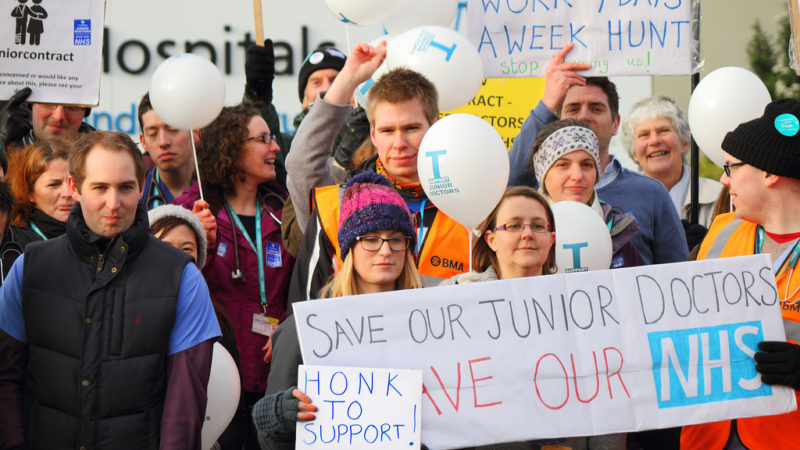A new report sets out a plan to reverse the union movement's decline. Leaders should listen closely.

For those of us who want to see our economy shifted towards the interests of working people, here’s a stat which matters: just 13% of private sector workers are members of a union.
Today the Changing Work Centre – a joint initiative between the Fabian Society and Community union – have published an extensive plan to turn that around.
At a time when Labour party support and membership seems resurgent, the long-term collapse in membership of the wider labour movement is a pretty stark and worrying contrast. Private sector union membership is now less than a third of what it was in 1979. And the self-employed workforce will soon outnumber those in the (largely unionised) public sector.
While most European countries have seen some decline since the shift towards laissez-faire economics in the 1980s, decline towards oblivion is not inevitable. But it is possible.
At the same time, the Fabian study reveals that three in five (59%) private sector workers believe that trade unions are necessary to protect working conditions. So why the slow-motion collapse?
The reasons are complex and historical – but that doesn’t let unions (or free-riders) off the hook. The problem is a collective action one: people want unions, they just don’t think they have to join them: ‘As long as they exist somewhere in the distance, we’ll be OK’. Obviously that’s not how membership organisations work.
The brutal truth is that there is no god-given assurance of the movement’s survival.
And while young private sector workers are broadly positive about unions, many think unions are ‘not for me’. Unions feel distant from young private sector workers’ day-to-day experiences. And they have a diversity problem that is putting off prospective members.
The study rings true: can you think of a young union leader? When was the last time you saw a BME union representative or one in their 20s or 30s on the TV or radio?
Future Union has a set of demands for the movement to change these perceptions – and put unions on the front foot again. It argues they need to:
- Establish a clearing house role for the Trade Union Congress (TUC) in the 150th anniversary of its foundation: i.e. you join the TUC, and your membership can follow you into different sectors and types of work
- Be representative of the workforce they represent: they must address the diversity deficit at a leadership level
- Set up career development centres to help people prepare for their future
- Get better at selling themselves: unions should ‘echo the marketing strategies of disruptive start-up businesses’
- Introduce discount membership rates: unions should offer discounted membership deals to under 35s and to workers in unrecognised workplaces
- Provide ‘instant breakdown cover’ for workers with preexisting problems. At the moment most unions won’t deal with problems members had before they joined the union: a huge disincentive to signing up. ‘Unions should follow the lead of the AA.’
The report also recommends finding out how workers join each sector – and start from the beginning of their careers: whether that’s apprenticeships, internships, training or education. They should develop apps and tech-based solutions to organise isolated and dispersed workers. And they should make the most of Big Data: unions are sitting on huge amounts of data – they should use it to improve their campaigning.
Cameron Tait, head of the Changing Work Centre and author of the report, said:
“Trade unions have a mountain to climb to stem four decades of membership decline, but it is not insurmountable. Our research shows the majority of private sector workers support unions and the work they do, but unions must plug the gap between instinctively positive attitudes and workers actually deciding to become members.
“Our recommendations for unions to improve their practices, collaborate with each other, and work in partnership with business and government provide a roadmap to a membership renaissance.
“Millions of workers could stand to benefit from the work trade unions do, with pay flatlining, insecurity at work rising, and technology rapidly changing the nature of work. This report shows how that can happen.”
The Community union have launched a project called ‘indycube’ for self-employed workers – which tackle this problem by ending late payments and providing instant, free legal assistance for self-employed workers. It’s a start, but we’re going to have to start seeing much more like this.
Alarm bells have been ringing for unions for a long time, but now the tolls are deafening. Every General Secretary should now be looking closely at these recommendations – and acting on them.
Josiah Mortimer is Editor of Left Foot Forward. Follow him on Twitter.
See also: We need unions as much as ever. The challenge is finding new ways to organise




One Response to “The end of trade unions isn’t inevitable – but it is possible. Here’s how they can reverse the decline”
Jimmy Glesga
The trade unions are suffering loses due to their own behaviour during the post war era until the late seventies when they were almost wiped out by the Thatcher government. The end of the closed shop where people were forced to join has been a major factor in the decline. The inflitration by variou left factions using the unions for their own political ends was another factor. Some union officials forgot it was their duty to represent the members on a day today basis.